September 2018 – Volume 20, Issue 6
IN THIS ISSUE
Flanigan’s Eco-Logic: Finding Jean-Luc in France
Quote of the Week
Coal Drops to 25% Nationally; California Reaches for 100% Renewable
4 Million Electric Vehicles and Growing… Fast!
Massive SUMR Wind Turbines
The Future of Food: Insects on the Menu
Microplastics
New “Microgrids, Resilience, PERCs” Video
Intern Report: Blockchain Technology
Nominations for EcoMotion’s Annual Energy Innovation Tour
The Boring Company News

Jean-Luc and Ted 1982
Flanigan’s EcoLogic: Finding Jean-Luc in France
Finished with my graduate studies, I packed my backpack and guitar and headed to Europe. For four months in 1982, I traveled, marveled, made friends, played music, drank, sang, ate… and much more. Today is great, but that was the time of my life!
Crossing the English Channel from Dover to Calais I met Jean-Luc. My age, traveling alone, we bonded over high seas, liquor, and my limited French. We split in Paris but agreed to meet a few weeks later in his home town of Bellentre… high in the French Alps. We became good buds. I witnessed and admired his rural, Alpine lifestyle. His father was a vacher, a cowman who took his herd high into Alps in summer for the sweet grasses that make the region’s delicious cheeses.
Ten years later, when I was invited to speak at the French Energy Management Agency in Antibes, France, I visited Jean-Luc again. By then he was married and Nathalie spoke English well, which was great. They were running a restaurant in a ski town nestled on the mountainside. I helped prepare for the season, planting flowers and staining the floor.
This summer I wanted to find Jean-Luc. We’d been out of touch for 26 years. I searched for my black address book and came up dry. Those are a thing of the past! I couldn’t locate him on the internet either. So, when planning our July 2018 European adventure, Terry and I decided to visit Bellentre… to knock on doors if need be, and to see if we could find Jean-Luc
Stick shift, five on the floor, sporty Peugeot compact… today we were off on a mission! We drove hours into the mountains, from Annecy past Albertville to Bellentre… a tiny commune on a hillside near the Swiss border, an idyllic setting. I remembered a boulangerie and tabac in Bellentre. That’s where we would begin the search. Certainly someone would know Jean-Luc and his family.
But both stores were shut down. The sleepy town had gotten sleepier. So I got bold and began approaching people on the street, then knocking on doors. Lots of them. An old Frenchman saw no humor in my quest, but another lady wanted to help and took us to her parent’s home. She had a feeling they might know. Yes, they did know the Villien family. In fact, they’d bought their home from Jean-Luc’s parents. I’d been in that home. They knew that Jean-Luc had moved away, but they told us that his brother still lives in town.
Up the hill we went to the brother’s house, where the only life was a semi-threatening German Shepard untied in the yard. I befriended the dog just enough to cross the yard and knock. Work boots at the front door were encouraging, but all quiet. So we began knocking on his neighbors’ doors. One neighbor thought she knew Jean-Luc’s wife Nathalie. He thought that she works at Les Cloches… a ski area across the valley and even higher above the valley floor.
Back in our sporty car, we bombed up there, through switchbacks, enthralled by spectacular views. The ski town was dead; only a handful of summer workers tackling off-season construction projects. There was an open bar and the owner said that yes, he knew Nathalie! She worked at a restaurant chalet even higher on the mountain. So we wound through another dozen switchbacks, across ski slope’s green grasses with grazing brown cows with classic cowbells clanking. Then we found it, a small restaurant with the world’s very best view of Mt Blanc.
In we went and an attractive woman welcomed us. Yes, her name was Nathalie… Yes, Nathalie Villien. We couldn’t believe it. We found her! “Do you remember me?” I fumbled in French. And then, after a perplexed moment, she realized that I was looking for “the other Nathalie!” With the same name in a small valley, they’d been through this before. She knew the Nathalie and Jean-Luc Villien that we were looking for. They’ve moved away. She went online and came back with their current address and phone number. “This is who you are looking for!” We sat, ate salad, and marveled at it all.
We’d been hunting for hours. I tried calling “the right Nathalie” to no avail. One more chance we thought. So, we headed another 120 kilometers directly to their home, stopping only to swim in the refreshing glacial waters of Lake Annecy. Then we drove directly to the address we’d been given. At 5:30 that evening, the right Nathalie opened her door. She remembered me. Boy was she shocked. She called Jean-Luc and told him to get home ASAP. She had a surprise for him!
Jean-Luc bounded up the steps and we hugged. In fact, I kissed him Euro-style! Success. The same bond we had then was instantly rekindled. We beamed with smiles, reconnected as two families, and ate and drank the night away. Nathalie pulled out old photo albums with pictures of me. What a feeling to find a long-lost friend. It wasn’t at all weird… No, it was great! It became so clear why we made the effort. Now our families are planning next summer’s travels together. Finding Jean-Luc and Nathalie was a major highlight of our trip.
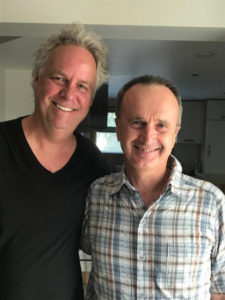
Jean-Luc and Ted 2018
Quote of the Week
“When it comes to fighting climate change and reducing our reliance on fossil fuels, California won’t back down. We have doubled down.”
California State Senator Kevin De Leon
Coal Drops to 25% Nationally; California Reaches for 100% Renewable
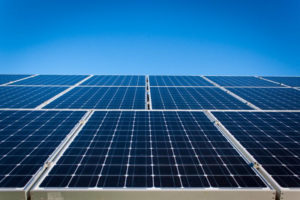 A decade ago, coal was used to generate half the nation’s electricity. Now that percentage has dropped nearly to 25%… cut in half in ten years and on its way further down despite presidential efforts to prop up “ailing coal-fired power plants.” Today it’s all about renewables. Several major utilities – including American Electric Power and Duke Energy, are continuing with their plans to retire coal-fired capacity, despite the dismantling of the Clean Power Plan and the introduction of the Affordable Clean Energy rule.
A decade ago, coal was used to generate half the nation’s electricity. Now that percentage has dropped nearly to 25%… cut in half in ten years and on its way further down despite presidential efforts to prop up “ailing coal-fired power plants.” Today it’s all about renewables. Several major utilities – including American Electric Power and Duke Energy, are continuing with their plans to retire coal-fired capacity, despite the dismantling of the Clean Power Plan and the introduction of the Affordable Clean Energy rule.
As a nation, we consume about 4,000 TWh (terawatt-hours) of power each year. While coal fell from supplying 1,986 TWh of electricity in 2008 to 1,084 TWh in 2018, solar increased from 56 TWh to 400 TWh in the same date range. Solar now provides more than 10% of instate power generation in five states: Massachusetts has joined California, Hawaii, Nevada, and Vermont.
According to the Energy Information Administration, solar provided 2.4% of total U.S. generation for the first half of 2018… solar plus wind provided just shy of 10% nationally. In the first half of 2018, the U.S.DOE reports that renewables provided 19.867% of all generation in the United States, ever so slightly ahead of nuclear power with 19.863%.
 In late August, California’s State Assembly passed SB 100, a bill that will require 100% of the State’s power to be renewable by 2045. It also accelerates the State’s renewable portfolio standard from 50% renewable by 2030 to 60%. Second only to Hawaii in its 100% proclamation, and with Senate approval, pending the Governor’s signature, some call this the biggest step California has ever taken to fight climate change. The State currently gets 44% of its power from renewables including hydropower.
In late August, California’s State Assembly passed SB 100, a bill that will require 100% of the State’s power to be renewable by 2045. It also accelerates the State’s renewable portfolio standard from 50% renewable by 2030 to 60%. Second only to Hawaii in its 100% proclamation, and with Senate approval, pending the Governor’s signature, some call this the biggest step California has ever taken to fight climate change. The State currently gets 44% of its power from renewables including hydropower.
Many believe that SB 100’s big beneficiaries may be energy storage and transmission providers. Analysis shows that California will need 200 times as much energy storage capacity as it currently has to be able to retire gas plants. The Clean Air Task Force, a Boston based non-profit, believes the State will require 36.3 million MWh of energy storage by 2045. Right now, there is 150,000 MWh of storage in California including pumped storage facilities. To support this great need, the California Assembly and Senate passed SB 700 that will extend the Self Generation Incentive Program (SGIP) for five years to 2026, adding 3 MW of eligible storage capacity and $800 million to the incentive pot.
4 Million Electric Vehicles and Growing… Fast!
 In late 2015, global electric vehicle sales reached the 1 million mark. That took 60 months. In 2018, global sales hit 4 million, and the fourth million was sold in less than 6 months. According to Bloomberg New Energy Finance, EV sales are expected to reach 5 million in May of 2019.
In late 2015, global electric vehicle sales reached the 1 million mark. That took 60 months. In 2018, global sales hit 4 million, and the fourth million was sold in less than 6 months. According to Bloomberg New Energy Finance, EV sales are expected to reach 5 million in May of 2019.
The regional composition has shifted. As the chart suggests, North America and Europe dominated purchases of the first million EVs with 39% and 33% respectively, and Asia with only 15%. Now China accounts for 37% of all EV sales since 2011 and around 99% of ebuses.
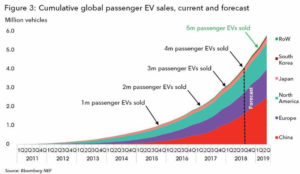 The rise of EVs ties with increasing demand for batteries in stationary applications. Retired EV battery packs will be used for stationary locations, a volume expected to be 108 GWh in 2029. Separately, Bloomberg projects that the global storage market will reach 305 GWh by 2030. Spent EV batteries could provide a third of the stationary storage requirement.
The rise of EVs ties with increasing demand for batteries in stationary applications. Retired EV battery packs will be used for stationary locations, a volume expected to be 108 GWh in 2029. Separately, Bloomberg projects that the global storage market will reach 305 GWh by 2030. Spent EV batteries could provide a third of the stationary storage requirement.
In tangential news, the U.S. Army is making renewable energy waves, this time installing the largest stand-alone battery system in the United States, a 4.25 MW/8.5 MWh storage system at Fort Carson in Colorado.
Landmark Behind-The-Meter Solar Installation
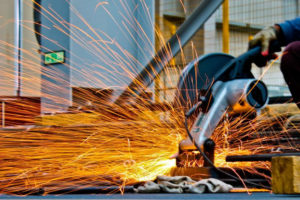 Excel Energy Colorado has reached an agreement to build a 240 MW solar facility on a customer’s site, at the EVRAZ Rocky Mountain Steel in Pueblo, Colorado. Using a Power Purchase Agreement, the solar system’s output will be sold to EVRAZ for 22 years. Pending Colorado Public Utilities Commission approval, it is believed to be more than an order larger than any other net energy metered (NEM) facility in the United States.
Excel Energy Colorado has reached an agreement to build a 240 MW solar facility on a customer’s site, at the EVRAZ Rocky Mountain Steel in Pueblo, Colorado. Using a Power Purchase Agreement, the solar system’s output will be sold to EVRAZ for 22 years. Pending Colorado Public Utilities Commission approval, it is believed to be more than an order larger than any other net energy metered (NEM) facility in the United States.
From the customer standpoint, the deal will lock in electricity prices and savings through 2041. Long-term energy price security was a first and critical step for considering future investments in the plant. The deal will allow the mill to expand its operations, beginning by modernizing its hot-rolling operations.
The NEM project supports Excel’s Colorado Energy Plan which calls for retiring 660 MW of coal-fired capacity at its Comanche station while adding 1,100 MW of wind, 700 MW of solar, and 275 MW of battery storage, and acquiring 385 MW of existing gas-fired generation. The $2.5 billion plan will help the company reduce its CO2 emissions by 60% by 2026. At that time, 55% of Excel Energy’s power will be renewable.
In San Francisco, Salesforce Tower has signed a 15-year Power Purchase Agreement with EDF Renewables to fund the development of the $300 million Bright Stalk Wind Farm in Illinois. Salesforce is committed to purchasing 100% renewable power by 2022.
Massive SUMR Wind Turbines
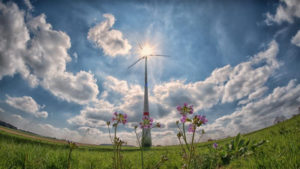 Researchers at the University of Virginia, in partnership with the National Renewable Energy Laboratory (NREL), have been funded with a $4.1 million ARPA-E grant to construct and test the world’s largest wind turbine. Called the Segmented Ultralight Morphing Rotors for Wind Energy (SUMR), each turbine will stand taller than the Eiffel Tower.
Researchers at the University of Virginia, in partnership with the National Renewable Energy Laboratory (NREL), have been funded with a $4.1 million ARPA-E grant to construct and test the world’s largest wind turbine. Called the Segmented Ultralight Morphing Rotors for Wind Energy (SUMR), each turbine will stand taller than the Eiffel Tower.
SUMR adds an order of magnitude to turbine size, increasing the largest turbines from 5 – 10 MW today to 50 MW. SUMR, using downwind technology, is designed such that its blades deflect in the wind, acting like a palm tree to accommodate a wide range of wind speeds up to hurricane-force winds. Its blades are manufactured in sections to reduce production, transportation, and installation costs.
In related news, a new study finds that New Jersey offshore wind could create 40,000 jobs in the Garden State by 2028. Furthermore, every megawatt of wind power has significant economic development value as it requires significant resources… 103 tons of steel, 402 tons concrete, 3 tons of copper, 20 tons of cast iron, and 6 tons of fiberglass.
New Jersey intends to release an RFP for 1,100 MW of offshore wind, opening bidding by the end of this year, such that participating projects are in time to get federal production tax credits slated to end at the end of next year. With only 30 MW of offshore wind installed throughout America at this time, New Jersey’s Governor Murphy set an aggressive goal of 1,100 MW of offshore wind by 2025, and 3,500 MW by 2030.
The Future of Food: Insects on the Menu
 The world population is soaring, food production is experiencing bigger demand than ever before, and given land scarcity, overfishing, and threats from climate change, traditional animal farming is unsustainable.
The world population is soaring, food production is experiencing bigger demand than ever before, and given land scarcity, overfishing, and threats from climate change, traditional animal farming is unsustainable.
There’s not enough land left in the world for everyone to follow USDA dietary guidelines. Experts claim that we’d need a gigahectare (3.8 million square miles), to feed everyone to the U.S. standard, requiring a chunk of fertile land the size of Canada. Making matters worse, the current U.S. diet ingests more meat than the USDA guideline. Thus, the United Nations and others such as the Insect Protein Association of Australia are looking at new ways of sourcing food, alternatives to conventional livestock.
Insects? Yes, bugs stack up well to beef in terms of nutritional value as well as sustainability.
“Entomphagy” is the human use of insects as food. Before humans had tools to hunt and farm, many relied much more on insects. Eggs, larvae, and pupae, of certain insects have been eaten by humans since pre-historic times to the present day. Over 1,000 species of insects have been eaten in 80% of the world’s nations from Central and South America to Africa, Asia, Australia and New Zealand. Edible insects include crickets, cicadas, grasshoppers, ants, beetle grubs, mealworms, bamboo worms, mopani worms, silkworms, waxworms, scorpions, and tarantulas. The Food and Agriculture Organization (FAO) suggests that there were as many as 2 billion insect consumers worldwide in 2006. It’s only uncommon in America and Europe.
Companies are now trying to introduce insect food in Western diets. Tortilla “chirps” are made of crickets milled into flour to create crunchy, healthy eco-snacks. The chirps require one gallon of water per pound to grow, versus 200 gallons for beef, and they have more protein and less fat. A Swiss start up called Essento sells Insect Burgers made of protein-rich mealworms; Essento Insect Balls are made of flourworms blended into chickpeas, onions, garlic, and spices.
Microplastics
 Plastics are materials consisting of both synthetic and semi-synthetic organic compounds. They are malleable; they can be easily molded. Plasticity, the general property, is the ability to bend without breaking. Most plastics are synthetic, and most are derived from petrochemicals. They are low cost, easy to manufacture, versatile, impervious to water, and have therefore prevailed over traditional materials such as wood, stone, bone, horn, leather, metal, glass, and ceramic.
Plastics are materials consisting of both synthetic and semi-synthetic organic compounds. They are malleable; they can be easily molded. Plasticity, the general property, is the ability to bend without breaking. Most plastics are synthetic, and most are derived from petrochemicals. They are low cost, easy to manufacture, versatile, impervious to water, and have therefore prevailed over traditional materials such as wood, stone, bone, horn, leather, metal, glass, and ceramic.
The first plastic was invented in 1907 in New York by Leo Baekeland who coined the term plastic. The Greek work “plastikos” means being capable of being shaped or molded. Plastics can be pressed and extruded. Other chemists have followed suit with polymer chemisty. In developed countries, about a third of plastic is used for packaging, about a third for building materials such as insulation, piping, conduit, and vinyl siding. Other uses of plastics are in autos (about 20%), medical equipment, furniture, and toys.
Since modern plastic was first mass-produced, more than 8 billion tons have been manufactured, much of it by BASF and Dow Chemical. Today, global plastic production is ~300 million tons per year. In 1930, nylon was first introduced by DuPont and reportedly revolutionized the plastics industry at the time. In the first ten years of this century, our global civilization demanded more plastic than in all of the 20th century. Eight million tons of plastic ends up in the ocean every year. Plastic sales are nearing a trillion dollars a year.
Most plastic is inert, it does not readily react chemically with other substances. It is resilient, durable, and thus doesn’t easily degrade. That’s what makes it valuable. But this slow rate of degradation is also at the root of its environmental concerns. Over time, plastic sheds the chemicals that make it useful, phthalates and bisphenol, breaking down partly. Plastics also attract other chemicals, like PCBs. Some say that plastic becomes “a chemical Trojan horse.”
Plastic is one of the most enduring products made. It takes 500 – 1,000 years to degrade, while 50% of all plastic made is used once and then thrown away. When it is thrown away, it does not disappear. Much of it crumbles into small pieces. Microplastics are smaller than 5 millimeters, about the size of a grain of rice. They’re everywhere… in oceans, rivers, lakes, and in soil. Researchers at the University of Toronto are studying microplastics in our food chain. They document microplastics in drinking water, in beer, in sea salt, in fish and shell fish. Ecotoxicologists find that plastic particles do not pass harmlessly through the body. They can damage organs, and leech hazardous chemicals, compromising immune systems and growth and reproduction. It is time to take action.
The Danish company, Lego, whose product is plastic, realized that it had to retool given concerns about plastics in the environment. Lego has announced that it intends to completely eliminate the use of plastics for the 100 million Lego pieces it produces each year, switching to plant-based and recycled materials by 2030.
New “Microgrids, Resilience, PERCs” Video
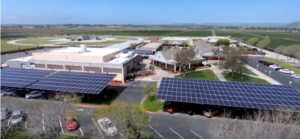 In August, EcoMotion released a 6.5-minute video called “Microgrids, Resilience, PERCs” that features the Santa Rita Union School District case study. There, EcoMotion helped the District finance six Powered Emergency Response Centers (PERCs) to “harden” its school sites in short-term outages, and to provide for first responders and community needs in the event of a prolonged outage.
In August, EcoMotion released a 6.5-minute video called “Microgrids, Resilience, PERCs” that features the Santa Rita Union School District case study. There, EcoMotion helped the District finance six Powered Emergency Response Centers (PERCs) to “harden” its school sites in short-term outages, and to provide for first responders and community needs in the event of a prolonged outage.
The video documents the team effort at SRUSD and presents opportunities for scaling the model to other schools with and without solar. Hosted by Ted Flanigan, featured interviews include SRUSD Superintendent Dr. Shelly Morr, Jigar Shah of Generate Capital, and Kirk Stokes of Sharp’s Energy Systems and Solutions Group.
Intern Report: Blockchain Technology
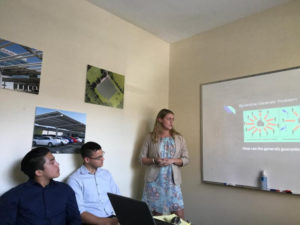
Jenny Miller presents her blockchain research
Two of the most popular current terms in our industry are “microgrids” and “blockchain technology”. We’re pleased to post the White Paper prepared by our Summer of 2018 Intern, Jenny Miller, titled, “Blockchain Technology: What It Means for Renewable Energy.”
Jenny does a good job of explaining blockchain in lay terms and how its secure communications addresses age-old dilemmas such as the Byzantine General’s Problem. While blockchain enables a future marked by distributed energy resources, blockchain is based on redundant systems that use lots of power:
“The dense computation completed by nodes is essential to the security of information held within a Blockchain network. The common term for these intense calculations is mining. Like mining any precious good, the chances of finding the desired outcome in Blockchain is very small because there is only one code that will work for any given transaction. So, while Blockchain may be a completely virtual technology, it takes massive amounts of energy to physically power the computers supporting it. Research completed in 2016 predicts that the Bitcoin network alone will require the same amount of electricity as the entire nation of Ireland by 2020.”
Nominations for EcoMotion’s Annual Energy Innovation Tour
 EcoMotion is making plans for our Annual Energy Innovation Tour in Los Angeles. Past tours have been highly inspirational and informative. We have witnessed a 16 MW solar installation, been to Proterra’s ebus factory, visited Tesla, and much more. Do you have a site to nominate for this year’s tour? If so, let us know. Please contact Shaun Miller at SMiller@EcoMotion.us and stay tuned for more tour details!
EcoMotion is making plans for our Annual Energy Innovation Tour in Los Angeles. Past tours have been highly inspirational and informative. We have witnessed a 16 MW solar installation, been to Proterra’s ebus factory, visited Tesla, and much more. Do you have a site to nominate for this year’s tour? If so, let us know. Please contact Shaun Miller at SMiller@EcoMotion.us and stay tuned for more tour details!
The Boring Company News
Elon Musk is omnipresent. Just the other day, his Boring Company announced plans for an underground public transportation system that would shuttle fans 3.6 miles underground to Dodger games in Los Angeles. Called the “Dugout Loop,” the plan would alleviate cars at Chavez Ravine. Instead, ticket-holders will “load into pod-like electric skates” that will transport 1,400 fans from East Hollywood to the stadium in less than four minutes. Each skate will hold 8 – 16 passengers and will travel at up to 150 miles per hour. Construction will take 14 months.
